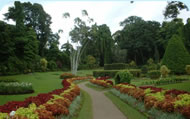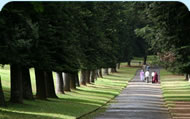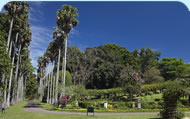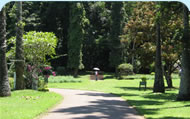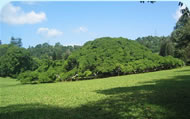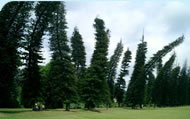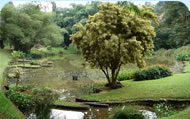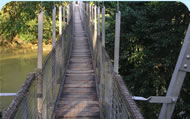The location of the finest of its kind in Asia
Peradeniya Royal Botanical Gardens, the finest of its kind in Asia, the largest of the botanical gardens of Sri Lanka, couldn't be better located. In the Mediterranean climate of Kandy, the gateway to the Central Highlands, the Gardens, at an elevation of 500 meters above sea-level, were tightly bounded on three sides by a loop of River Mahaweli (Great sandy river), the largest river of Sri Lanka.
The town of Peradeniya is located at a distance of 110km from Colombo and another 6km over the Peradeniya Birdge and you are at Kandy, home to the sacred Temple of Tooth.
Peradeniya, the name
Peradeniya is believed to take its exotic name from Sinhalese names Pera (guava) and Deniya (a plain). The name also reveals, although Guava is not indigenous to Sri Lanka, introduction of the fruit to the island and cultivation had occurred even prior to the era of British Colonialists in Ceylon.
The official establishment of Peradeniya Botanical Gardens during the colonial era
It was British colonialist rulers (1815-1948) of Ceylon, who destroyed the invaluable forest cover of a thousand wooded hills from Kandy to Badulla of Central Highlands of Ceylon that was protected by the gentle sway of Buddhism, which indoctrinated the respect for all living beings.
The wooded hills were converted to hill after hill of Ceylon Coffee and following the devastating "coffee rust" (a leaf blight - Hemileia vastratrix) in 1869 to seamless hill plantations of Ceylon Tea.
The very same British Colonialist rulers of Ceylon established the Peradeniya Botanic Gardens that contribute, today, towards the enlightenment of concepts of floriculture conservation, birdlife conservation, butterfly conservation, biodiversity and sustainability of the island of Sri Lanka: 5% of the school children of Sri Lanka visit the Peradeniya gardens every year.
The vegetation
The vegetation is purely tropical, being characterized by an abundance of climbing plants or lianas, palms, bamboos, pandanus or screw-pines, epiphytes (orchids, ferns etc.), and lofty trees, the latter often having buttresses roots. The leaves are generally large, thick and leathery; the flowers usually brilliant and considerable in size, and the fruits often of immense proportions and borne on the trunks of trees or older branches.
H.F. Macmillan, F.L.S, F.R. H.S. 1906 (Curator)
4000 labeled species of flora at Peradeniya Botanical Gardens
A signboard at the entrance, with a map, feature a numbered circuit from 1-30. The corresponding numbers are placed at strategic points on the route, black on a yellow background. 60 ha (150 acres) gardens, where you can easily stroll around a whole day, are stuffed with a bewildering variety of local & foreign tree & plant species. There are around ten thousand plants & trees inclusive of 4000 labeled species. One of the most interesting sites here is bizarre-looking snake creeper, whose tangled aerial roots look just like a writhing knot of vipers.
Main entrance, River Drive and avenues
Main entrance opens up the River Drive which takes you straight down to the great circle and then on to the suspension bridge over the River Mahaweli. River drive branches off to a number of avenues: Double Coconut Avenue, Cook's Pine Avenue, Royal Palm Avenue, Palmyrah Palm Avenue and Cabbage Palm Avenue
The spice garden, Orchid house
The spice garden to the right of entrance is replete with exotic spices. Cardamom, Coves, Pepper & Vanilla. We follow the path to the right, right into the Orchid House with an outstanding collection.
The great circle and memorial trees
The great circle is a grassy central area of nearly 4 acres in extent. Around the circle is a diverse array of trees planted by dignitaries, who had visited the Peradeniya Royal Botanical Gardens.
A "Flamboyante" of Madagascar (Poinciana regia), planted by Princess Henry of Prussia in 1899; a "Bo" (Peepal) tree (Fiscus religiosa), planted in 1875 by King Edward VII; a "Na" tree, or Ceylon Ironweed (Mesua ferrea), planted in 1891 by Czar of Russia; Brownea grandiceps tree planted by the King of Greece in 1891; Amherstia nobilis, planted by Prince Henry of Prussia in 1898;‘Asoka" tree (Saraca indica) planted by Emperor of Austria in 1893; "Cannonball" tree (Couroupita guianensis), planted by the Prince of Wales in 1901.
Alongside generations of European royalty, there are trees planted by Indira Gandhi, then Prime Minister of India; Yuri Gagarin, the first man to circle the orbit of earth, thereby cracking the door to space; Marshal Tito, the man who rebuilt Yugoslavia devastated in the Second World War; U Thant, the Secretary-General of the United Nations during the decade from 1961 to 1971 & Supermac Maurice Harold Macmillan, 1st Earl of Stockton, Prime Minister of the United Kingdom during the period of 1957 to 1963. Between the great circle & the great lawn is the Herbarium. Then there is an arboretum.
Lawns, pavilions, sandwiches & a cup of tea
There are extensive well-kept lawns, pavilions, an Octagon Conservatory, fernery, banks of Burmese, Chinese & Japanese bamboos & numerous flower borders with cannas, hibiscus, chrysanthemums, croton & colorful bougainvillaea. You will see unusual exotic species, especially palms (Palmyra, talipot, royal, cabbage) & Ficus elastica (latex-bearing fig or "Indian rubber tree" with buttress roots), an amazing avenue of drunken looking pines & some magnificent old specimen trees. Then there are Ebony collection, Fiscus collection, Cycad Collection, Flower garden, Medicinal Garden, Cactus house and Plant house.
Natural pavilion
Grown from a sapling brought from East Indies, huge Javan fig tree covering 1600 sq. meters of the lawn, with its sprawling roots & branches create a remarkable natural pavilion.
The Cabbage Palm Avenue
The Cabbage Palm Avenue from the South America was planted in 1905. Walking along the stately avenue of Royal Palms (1885) we find fruit bats in large colonies hanging in the trees. Oh! Yes, true to their style, upside down.
Cannonball avenue
Cannonball Avenue is lined with beautiful cannonball trees, wreathed in creepers from which hang the large, round fruits. These Sal trees are loved by the Sinhalese. The flowers have a singular shape: a tiny stupa shaped bud in the centre is shaded by a cobra like hood & surrounded by tiny florettes which resemble a crowd of worshipers. It is believed Prince Siddhartha (who was to become Gautama Buddha) was born in a park of Sal trees called Lumbini, near the Sakyan kingdom of Kapilavastu in then north India, now the southern region of Nepal.
Talipot palms
Talipot palms (Corypha umbraculifera) are the easiest to identify with its enormous leaves. The talipot palm is one of Sri Lanka's botanical celebrities, an arboreal oddity which flowers just once in its lifetime, after about forty years, producing the largest cluster of flowers in the world. In Kandyan times the enormous leaves reaching a height of 10 m were used to make tents by sewing a couple of leaves together. "One single Leaf being so broad & large, that it will cover some fifteen or twenty men, & keep them dry when it rains" wrote Robert Knox. Talpot leaves were utilized to produce fine ultra long lasting solid parchments called Ola, in Sri Lanka & India as early as in 500 BC. Young talipot leaves were boiled, dried in the sun, exposed to dew & smoothed & stretched. The treated leaves were then engraved with writing using steel stylus to cut in the characters. Then the engraved leaf was smeared with ink made out of a resin blended with finely powdered charcoal. The great chronicle of Sri Lanka (Mahawamsa) & all other ancient books were written on these treated, cut & loosely bound talipot palm-leaf parchments.
Artificial lake
In the centre of the Gardens is an artificial lake with water plants including the giant water lily & papyrus reeds. Beside the lake is a white-domed rotunda commemorates George Gardener, the Superintendent of the park during 1844-1849.
"Coco de Mer" or "Double Coconut Palm"
One of the rarest plants in the world, Coco de Mer (Lodoicea sechellarum) is on a path leading to this monument of Gardner. This plant has the largest & heaviest fruit or nut in the plant kingdom, weighing an average some10 - 20 kg. They take between five to eight years to mature & are surprisingly productive. It is not unusual to have 20 nuts on a tree. They are all carefully numbered. Native Coco de Mer are only found in Praslin, an island in the Seychelles. Strolling along the path we reach lily tank which is surrounded by giant bamboo, some 40m tall that grows 2-3 cm a day.
Suspension Bridge
Suspension Bridge across the River Mahaweli takes us to the School of Tropical Agriculture at Gannoruwa hill, where research is carried out into various important spices & medicinal herbs as well as into tea, coffee, coca, rubber, coconuts & varieties of rice & other cash crops.
Peradeniya campus
Just across the main road from the gardens is Peradeniya campus of Sri Lanka University (1942), built in the old Kandyan style in an impressive setting of a large park with the River Mahaweli running through it & the surrounding hillocks.
The History of Peradeniya Royal Botanical Park
The history of the park wouldn't take a backseat to its geography, terrain or vegetation. Conceived originally in 1371 as the Queen's pleasure garden, it was developed by King Kirti Sri Rajasinhe (1747-1778) where royal visitors were entertained. It was converted into Botanical Gardens in 1821, by the British during the deputy governorship of General Sir Edward Barnes, six years after fall of the last King of Sri Lanka.
Alexander Moon, the botanist
Alexander Moon, a diligent student of the Ceylon flora was appointed the superintendent of the Peradeniya Royal Botanical Gardens. In the year 1824, Mr. Moon published a "Catalogue of Ceylon Plants" with the description of 1,127 plates referring to same by native names as well as botanical names. Sri Lanka's first tea trees were planted here at Peradeniya Gardens in 1824, though the full commercial potential wasn't to be realized for another half a century.
All prime imported crops - Coffee, Tea, Nutmeg, Rubber & Cinchona - were tested in Peradeniya Royal Botanic Gardens. That was during the enterprising governorship (1824-1831) of Sir Edward Barnes. Imported crops, Tea & Rubber together with the local crop of Coconut became mainstay of the economy of the island in the time to come. After the death of Mr. Alexander Moon, a succession of superintendents followed.
George Gardner, the famous traveler botanist
In 1844, an aptly named Scotsman was appointed the Superintendent of Peradeniya Royal Botanical Gardens: Mr. George Gardner (born in1809 or 1812), a son of a gardener to 5th Earl of Dunmore. Mr. Gardener's deeds had already well surpassed the carry of his name: his expeditionary account of "Catalogue of Brazilian plants"numbered a collection of enormous 6100 plants.
Gardener collected the specimens during his four years of explorations in Brazil & was responsible for importing Rubber as well as Cinchona to Ceylon. Both of these imports have been blessings to the island; Rubber becoming a prime export & bark of Cinchona tree producing anti malaria drug Quinine.
Mr. Gardner, with great industry, launched upon the development of Peradeniya Gardens till his tragic death in 1849 with a fit of apoplexy at the Rest House of Nuwara Eliya, the prime sanatorium of the colonialists in the Central Highlands of Ceylon. His untimely death left his work towards a Ceylon Flora incomplete. "Gardner Monument" was erected at the park to his memory.
Dr. Thawaits's 30 years of unbroken selfless service to the Peradeniya Royal Botanical Gardens
Gardner was succeeded by a man who wouldn’t be his second best: Dr. Thwaites. Dr Thwaits’s term of service extended over thirty unbroken years, during which he never left the Island of Ceylon. A devoted student of the science of Botany, Dr. Thwaites is credited with bringing world wide recognition to the Peradeniya Botanic Gardens. He retired in 1880, and died in Kandy in 1882.
While their fellow Englishmen were busy game hunting, killing thousands of elephants, killing mammals and birds, those illustrious botanists of Ceylon at the Perdenaiya Royal Botanical Gardens, contributed with their tireless work towards enlightening their follow colonialists with the value in conservation of biodiversity and floriculture of our Sri Lanka Holidays.

